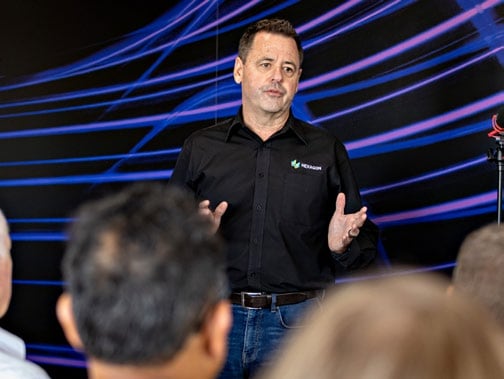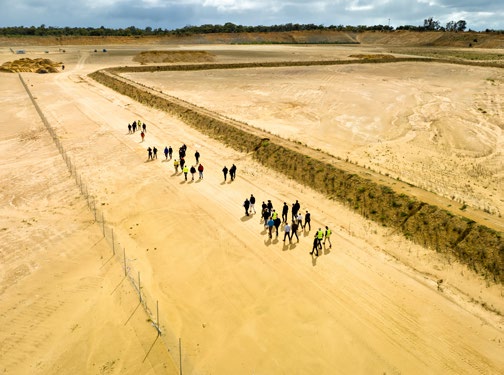Future-facing facility – The future of Australian mining is taking Shape at WA’s new high-tech testing centre

A new world-class Australian automation and robotics testing facility serving the mining sector is continuing to expand as a range of organisations, from Tier 1 miners to startups, increasingly utilise the site outside Perth.
The Australian Automation and Robotics Precinct (AARP) was established by the WA Government with a goal to create a collaborative environment that nurtures the development of cutting-edge technologies and techniques to accelerate sector-wide growth and competitiveness.
 Test and development activity at the site ramped up significantly in 2023 and is set to continue to grow in 2024 with the opening of the Precinct Headquarters later this year.
Test and development activity at the site ramped up significantly in 2023 and is set to continue to grow in 2024 with the opening of the Precinct Headquarters later this year.
Automation and robotics in Australia’s mining sector is expected to add $74b and create 80,000 new jobs by 2030 and the 51ha site in Perth’s northern suburbs is already playing a key role in the sector’s transformative process.
AARP’s national project lead Tamryn Barker says initial interest and uptake has been positive with one Perth-based robotics startup undertaking its first paid trial with a Tier 1 miner following a successful testing programme at the Neerabup centre, about 35km north of Perth.
“This is a big deal, being able to validate significant new technologies with customers at the site and derisk the process on both sides,” she said.
Industry uptake
The startup, an emerging WA hard tech developer specialising in designing and manufacturing automated robots to improve productivity and safety in the mining sector, was able to showcase its tech at the AARP in real-world conditions instead of conducting demonstrations at a Queensland mine site.
As an early-stage startup, utilising the AARP provided the company with low-cost access to test beds, as well as facilitated engagement with potential customers and opportunities to showcase its products at monthly Demo Days at the site, according to Ms Barker.
HydraTune chief financial officer Peter Campbell says his company, a remote hydraulic tuning company, is also realising the benefits of the AARP beyond the ability to test and develop technology at the site.
“To collaborate with other companies and access world-class facilities so close to the city, is so valuable to us,” he said.
The collaborative aspect extends beyond startups comparing notes, with established operations and Tier 1 miners increasingly utilising the AARP.
Hexagon is another high-profile company taking advantages of the WA location and onsite testing facilities offered by the AARP.
Hexagon VP Asia Simon Stone says the company is excited to be part of the AARP.
“We’ve done testing and a demonstration here with Mineral Resources to their investors and the media which went super well,” he said.
“When you introduce autonomy and innovation like this into an organisation we need to take people along for the journey. Creating that right culture, creating a feeling of excitement for this innovation is really important. “And this is a great facility to help you everyone is learning here. This is where we’re going to develop what we need, for these machines to be able to make decisions on their own and operate safely, and importantly, to get the hours up to ensure people are comfortable with the tech and to bullet-proof it from a safety and robustness point of view.”
“As announced in July 2023 by our chief executive Paulo Guglielmini, our project with Mineral Resources is the largest single contract Hexagon has ever done,” he said.
“We are seriously investing inside WA, having recently opened up a new office in the Perth CBD to accommodate 150 staff and establishing a substantial light industrial facility with around 30 specialist autonomous staff close to the AARP. So why WA? The iron ore industry in WA is really well-established. But the ore bodies that are now available are further apart.
The economics of taking drivers out of the cab is transformative. It makes dirt that was of no economic value, really valuable. “And especially as there are no drivers available, this brings opportunity for creating new, high-value jobs.”
“The disruptive technology of light touch, long haul transport of iron ore is creating an economic resource in Western Australia that wasn’t there before and is opening up new revenue streams for the State to invest in schools and communities. This technology has applications across Australia. It has applications across industry, including mining, military and agriculture.”
Ideal location
Australia is already a world leader in the application of industrial robotics and automation technology, with the Pilbara region of WA home to almost 75% of autonomous trucks operating globally and the world’s largest and longest autonomous trains hauling iron ore from pits to ports.
Leveraging this momentum, the AARP provides companies from diverse industries with seamless access to an innovative environment, essential tools, and comprehensive training required to develop, test, and showcase automation and robotics products and processes.
Launched in October 2021 by DevelopmentWA, the AARP, part of the WA Government’s Diversify WA strategic framework and operated by CORE Innovation Hubunder the management of DevelopmentWA since 2022, provides six test bed environments which allow companies and researchers an opportunity to accelerate industrial technology development by testing and scaling without interrupting normal production activities, in addition to other facilities.
Multiple test beds
The AARP test landscape suits a range of needs along the mining value chain, in particular exploration and discovery, drill and material movement. The largest test bed, the Dirt Lab Innovation Mine spans over 220,000m2 and has been designed to facilitate activity in these areas:
• Develop: use the test beds to develop and test new mining technologies, such as automation and robotics systems, before real-world deployment in operations.
• Demonstrate: use the test beds and facilities to demonstrate and train customers on the capabilities and benefits of their existing products, helping to increase sales and market penetration.
• Commission: use the test beds and leasehold lots to commission, optimise and integrate new equipment into their operations, reducing risk and increasing efficiency and productivity.
• Train & Educate: use the Precinct as an industry training hub and where universities can conduct research and provide hands-on learning opportunities for students, giving them exposure to cutting-edge mining technologies and techniques and embedding PhDs in industry projects.
The AARP are also shaping up a collaborative New Energy Zone, which will host infrastructure and activity co-designed with industry. This will include advancing work on the transformative role of automation and electrification; a development ecosystem for robotics and renewable capability with a solar array installation and maintenance area and charging infrastructure for industrial vehicles and energy storage and distribution. In turn, the New Energy Zone will support off-grid capacity to power other users across the precinct, for a truly sustainable hub and catalyst for green tech innovation in heavy industries and beyond.
Other test beds include a Flex Zone for flexible and adaptable technologies in various applications, including drone and smaller ground-going robot operations; a Heavy Zone with a bunded perimeter for safe testing of heavy vehicles and large field robotics; an Urban Zone with a test track to help accelerate the pace of urban and light industrial mobility and safety systems and solutions and a large technology showcase area for curated demonstrations and open days, bringing customers and stakeholders close to emerging technologies.
The future of AARP
Over the next three years, the AARP will be further developed, with a state-of-the-art Common User Facility operation building, research and development facilities such as laboratories and design co-labs, and advanced test beds with multiple areas and roadways for physical testing.
Construction is also underway on the Precinct Headquarters, expected to be completed mid this year.
The flagship building will feature coworking offices, research, development, and display areas.
It will also include laboratories, training and workshop facilities accessible to users, partners, and guests, and will be powered by emission-free solar power connected to a battery and microgrid network.
Leasehold lots are currently available on-site for test activities which provide direct access to the test bed areas and can be used for equipment laydown or storage.
The AARP, one of the biggest facilities of its kind in the world, also hosts monthly Demo Days to allow potential users and industry stakeholders to learn more about the project and technological developments.
To find out more visit: https://www.theaarp.com.au/






















